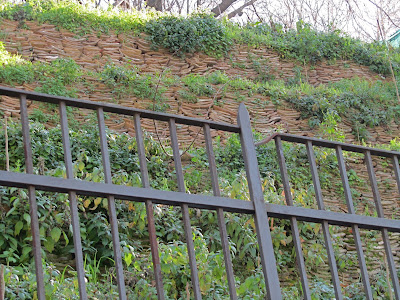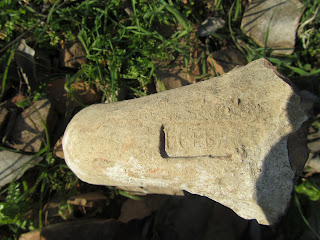When Caesar Augustus was emperor, about when BC changed to AD, the
population of the city of Rome was likely near 1.25 million. Nearby
agricultural areas couldn’t begin to supply that many mouths, so imports
from all around the Mediterranean were constantly coming up the Tiber from
the ports at Ostia. Though all the consumables have long since
disappeared, one very large remnant can still be seen.

|
| Monte Testaccio, looking southwest, with the Tiber River at top right. |
MONTE TESTACCIO
Just south of the Aventine Hill and
across the Tiber River from Trastevere is the section of Rome called
Testaccio (tey-stAH-tchō). From ancient times it was a working-class area, where all manner of
goods were off-loaded from barges and warehoused. The shipping
container of choice for bulk goods was the terracotta amphora, which was
produced all around the Mediterranean in a variety of shapes. (Amphora
comes from Greek, meaning two-handled jar.) In order to maintain
popularity the Roman Emperors provided free grain and olive oil to citizens,
while also supplying the military. The grain came mostly from Egypt,
but at least half a billion gallons of olive oil came from Spain. When
used for dry goods like grain, or liquids like wine, the amphorae could be
washed out and reused or smashed and used as a building material. But
olive oil couldn’t be washed out and not only would mortar not stick to it,
it also would form a vile, rancid film within the empties. So the
innovative Romans built Monte Testaccio to solve that problem.

|
| Amphorae in a model of an ancient ship's hull. |
Monte Testaccio is a man-made hill nearly 118’ (36 meters) high and about
0.6 mile (1 km) around the base. It was built between roughly 40 BC
and 260 AD, completely from broken terracotta amphorae, at least 25 million
of them, the pieces carefully stacked and packed for stability and efficient
use of space. An interesting oddity from antiquity, certainly, but it
has turned into an important archeological site because of the economic and
societal insights derived from inscriptions on the potsherds. Because
the hill is now a protected area, still being studied, it isn’t open to the
public most of the time. But we were able to join a small group
touring the monte one afternoon last week, led by Giovanni
Borgianelli Spina, who has made the history of Testaccio his passion.

|
| Giovanni Spina demonstrates the layering of potsherds. |

|
|
Archeological dating shows the hill was built up to about 40 meters
by 170 AD, when they started over again from ground level |
Testae in Latin means fragment or sherd; cocci means much the
same in Italian and as an adjective means earthenware; thus Testaccio.
When we walked around the hill at street level we could easily see areas
layered with broken pinkish burnt-orange terracotta. Exposed edges of
the terraced construction show how carefully the pieces were placed.
Once up on the hill, scattered amphora bits were everywhere underfoot—parts
of handles, pointed bases, sections of the mouths, and countless curved
sherds still bearing the 1900-year-old marks of the potters’ fingers and
tools on the inside surfaces. Although winter weeds and grass covered
much of the surface, a few clean areas marked where recent archeological
study shafts had been sunk into the hill then refilled. Many sherds have a white
coating of lime that was applied to combat mold and smells from rancid oil
while the hill was being built.

|
|
Above, southwest side of Monte Testaccio from street level. Below, on the north side of the hill the carefully stacked and terraced amphora pieces could scarcely be more compact. |

|
|
Potsherds everywhere. Below, a bit of pigment remains on a section of rim. |

|
| The site of a recent archeological shaft. |

|
|
Above, a white coating of lime shades many pieces. Below, finger marks left nearly two millennia ago. |
HISTORY
In the Imperial Roman era huge warehouses—horrea in Latin—were built
along the banks of the Tiber in what is now called Testaccio. There
are a few partial structures remaining today, but they barely hint at the
hundreds of thousands of square feet of multistoried, arch-roofed
repositories that once existed for grain, wine, olive oil, marble and other
imports. Because Rome didn’t have much in the way of exports, once
emptied into bulk storage the terracotta amphorae ended up in homes and
shops or were used as building material (sometimes inserted whole to quickly
fill volume, as in the Circus of Maxentius). But from the time of
Augustus the unusable ones were being tossed onto a pile behind the
storerooms. The gravimetric study that came up with the estimate of 25
million amphorae in Monte Testaccio found that original small, less dense,
disorganized pile at the very bottom, which soon becomes the denser,
carefully packed bulk of the hill. (Another source, widely quoted,
claims 53 million amphorae in the hill, but I don’t know how that figure was
derived. Either way, lots of pots.)

|
| The arcades of ancient horrea are preserved along the Tiber. |

|
| Inside a section of Imperial Roman warehouse in Testaccio. |
By the end of the 3rd century AD, Monte Testaccio was abandoned, emperors
and their policies having changed. In the middle ages there were
boisterous pre-Lenten carnevale festivities on the hill, and because
the barren monte in the middle of a deserted district reminded
clerics of Golgotha, it was arrayed with three crosses at Easter and
attended by the Pope. A cross remains atop the hill today as a
reminder of that use. In the 18th century there was a fine of 50 gold
scudi for grazing sheep on the hill. (Ironically, sheep are
used these days to keep down the weeds.) Otherwise it was mostly a
tourist attraction into the 19th century, providing a nice view over the
Tiber. Someone discovered that cool, perfectly ventilated wine cellars
could be made by digging into the terracotta hillside, and district
festivals were regularly held on and around the hill, fueled in part by
wine. In 1849, Giuseppe Garibaldi mounted artillery on the hill to
fend off an attack by French forces. The gun foundation is still
visible.

|
| Atop Monte Testaccio. A cross marks the summit. |
THE AMPHORAE

|
|
The archeological site's entrance ramp honors Dressel. |
Though earlier private collectors and intellectuals recognized its value,
Monte Testaccio has been scientifically studied only since the 1870s, when a
Prussian-born archeologist named Heinrich Dressel started sorting and
analyzing. His name has become part of amphora nomenclature, and it
turns out that an estimated 80% of the amphorae in the hill are a type
called Dressel 20. They are a bulbous 24” (60 cm) in diameter, hold
about 18 gallons (68 liters) and come from one river valley in the south of
Spain between Cordoba and Seville. Nearly all the other amphorae in
the hill came from northern Africa but also held olive oil, and are
identified with names such as Africanus and Tripolitana. What Dressel
discovered was a well-ordered set of descriptive notations (known as
tituli picti) painted on each amphora at the time of shipping which
reveal the oil producer, the shipping company, the tare weight and shipping
weight of the amphora. Initials identifying the pot manufacturer are
usually stamped into the clay, often at one end of a handle. A good
account of amphorae, with an eye toward modern shipping and marketing
methods, can be found at
this link.

|
| Dressel 20 amphorae found near the base of Monte Testaccio. |

|
| A handle stamped with the producing pottery's initials. |
I try to look at history in pragmatic terms; that is, I try to envision how
real people accomplished what they did. So when I learned that a
pre-industrial society mass produced tens of millions of nearly identical
amphorae over a period of 300 years or so, I wondered how they did it.
The imprints and shippers’ graffiti as well as analyses of the clay of
potsherds in Monte Testaccio link the Dressel 20-style amphorae to potteries
along the Guadalquivir River in Baetica, Spain, at least 100 of them.
But the same amphorae also carried olive oil to Britain and Gaul, so picking
a round production number, 60 million, how hard would those potteries have
had to work? If all 100 were active at the same time, 7 pots a day
each for 300 days a year for 300 years would make 63 million amphora.
Not forgetting the digging and transport of raw clay and the cutting and
transport of firewood for the kilns.
The big oil amphorae were built in two parts. The main globular belly
was built upside-down on a wheel, leaving a hole where the bottom point
would ultimately be to allow for drying air circulation. Starting with
a specified weight of clay and using gages and experience, the potter
reliably reproduced the desired shape and size. The bowl was sliced free of the wheel, and when it had firmed up, the bottom hole was plugged from inside by reaching through,
and the base then replaced on a wheel, sitting in a stabilizing bowl.
The separately formed neck and mouth were joined, followed by the
handles. The amphorae were fired in a kiln at between 1200 and 1475°F
(650–800°C).

|
| Two bottom tips, with the inside view showing the plug closing the drying hole. |
The district of Testaccio embraces its past and the origin of its name with
monuments and insignia, and it remains largely a working class
neighborhood. Many of the old wine cellars built into the base of the
monte have been turned into clubs and
restaurants, sometimes featuring a window into the ancient structure of the
hill. At the nearby district Mercato Testaccio you can
buy excellent olive oil, but not in an amphora.
Roberto

|
|
This monument to the amphora welcomes those heading into Testaccio on
Via Marmorata. [The amphora fountain has been moved to the site of the old covered market in Piazza Testaccio.] |

|
|
Above, a panino shop (pane imbottito means
stuffed bread). Below, a window into the hill in the restaurant Flavio al Velavevadetto. |











No comments:
Post a Comment